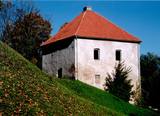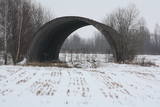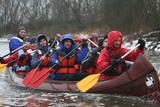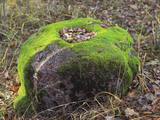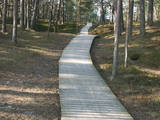| Nr | Nosaukums | Apraksts |
|---|---|---|
|
Kvadrātveida celtnes ar turpat divus metrus biezajiem mūriem nosaukums radies hercoga Jēkaba laikā, jo te glabāja šaujampulveri. Iespējams, ka te atradies akas namiņš, jo tuvu virszemei atrodas gruntsūdens. Pulvertorni ar pils fogteju savienoja 12 m garš tilts uz viena balsta. Mūsdienās tornis apskatāms tikai no ārpuses! |
||
|
Šķiet, ka viena no mūsdienās „teiksmām” visapvītākā Padomju armijas teritorija. Padomju laikā šeit atradās rezerves aviācijas lidlauks, kodolieroču noliktavas (... 50 km attālumā no valsts galvaspilsētas), kas bija nomaskētas zem diviem ar zemi apbērtiem un veģetāciju apaudzētiem betona angāriem. Publiskajā vidē ir atrodamas ziņas, ka noliktavās ir glabājusies 430 km smaga termiskā kodolbumba RX – 24 un 1030 kg smagā RX – 26 koldolbumba ar dažāda tipa kodollādiņiem, kā arī ar kodollādiņiem aprīkotās gaiss – zeme tipa raķetes. Kas gan būtu palicis pāri no Rīgas un valsts (Baltijas valstīm? Ziemeļeiropas?), ja šeit būtu noticis kāds negadījums? Šobrīd lidlauks ir slēgta teritorija.
|
||
|
Maršruts sākas un beidzas Lietuvā populārākajā piejūras kūrortā Klaipēdā. Klaipēdas Universitātes botāniskajā dārzā ir piekrastes etnogrāfiskais dārzs ar ziedu kolekcijām, kas raksturīgas šim apgabalam. Kretingas muižas parks ir viens no vecākajiem 16.-18. gadsimta muižas parkiem Lietuvā. Palangas muiža, kurā ierīkots Dzintara muzejs un Birutes parks ir viens no vislabāk saglabātajiem muižas kompleksiem Lietuvā. Lielākais japāņu dārzs Eiropā (16 ha) ir tradicionālo aromātisko augu un dārzeņu kolekciju mājvieta. Rucavas dendrārijs piedāvā apskatīt magnoliju kolekciju. Nīcas ciemā apmeklētājiem ir pieejami 7 dekoratīvie dārzi, kas uztur vietējās dārzkopības tradīcijas. Vēsturiskās šķirnes tiek rūpīgi izvēlētas, lai atjaunotu augļu dārzu un romantisko ainavu parku - 18. gs. Tāšu (Telsena) īpašumā Grobiņas rajonā, Latvijā. Izidorius Navidanskas parkā ir vairāk nekā 120 koku un krūmu sugu. Apmeklējiet āra augu izstādi Jadvyga Balvočiūtė saimniecībā – kur audzē ārstniecības augus un garšvielas, pārdod organiskos kāpostus, atsevišķas zāļu tējas un zāļu maisījumus. Beržoras lauku mājā, kas atrodas Žemaitijas nacionālā parkā, aug arī dažādi medicīnas, kulinārijas, aromātiskie un dārza augi. Plunges muiža, ko sauc arī par "Žemaitijas Versaļu" - ir viena no slavenākajām šāda veida muižām, kas saglabājusies Lietuvā. Steponas Darius dzimtās vietas muzejā ir unikāls augļu dārzs ar iespaidīgu izmēru un apjomu. Švėkšnas muižas komplekss ir apveltīts ar skulptūru parku, skaistiem skatiem, takām, vārtiem un ķīniešu-japāņu ginka koku (ginkgo biloba), kas ir 18 metrus augsts un 70 cm diametrā. Šilutes muižā ir divi parki - angļu ainavu parks ar pastaigu takām un mežaparku, kas pazīstams kā Varnamiškis, vai tā sauktais "Vārnu mežs". |
||
|
Uzņēmums nodarbojas ar dabas tūrisma pasākumu organizēšanu: vasarā laivošana ar kajakiem jūrā, rudenī – pārgājieni ar sniega kurpēm pa purvu, ziemā – pārgājieni ar sniega kurpēm, un pavasarī – laivošana ar kanoe laivām pa upēm. Dabas draugiem piedāvā tematiskas ekskursijas: pavasarī – lāču vērošanas safari un putnu vērošana, rudenī – aļņiem, roņiem un vilkiem veltīti tematiskie pasākumi. |
||
|
Latvijas lielākā ezeru sala, kas atrodas Usmas ezera vidusdaļā. Teritorija veidota uz salas augošo veco priežu audžu, augu un putnu aizsardzībai. Vislabākais veids - salu apskatīt no laivas, braucot pa Usmas ezeru. |
||
|
Zīleņu upurakmens. Zelenpoles Zelta kalniņā, pie stāvas nogāzes,
apskatāms akmens ar gredzenveida iedobi vidū – Zīleņu upurakmens.
Te bija sena latgaļu kulta vieta, kur nesuši upurus dieviem, attīrījušies
no ļauna un smēlušies gaišo enerģiju.
|
||
|
Saimniecības laukos vasaras vidū zied rapši un lini. To apstrādei uzbūvēta rapšu un linu sēklu eļļas spiestuve. Eļļas spiešanas procesa vērošana, eļļas iegāde.
|
||
|
Kafejnīca "Dzirnas" atrodas Gaigalavas centrā – bijušajā kolhoza administratīvā centra ēkā. Ēdiena gatavošanā izmanto produktus no savas un citām lauku saimniecībām. Latviešu virtuve: Pupu zupa ar grūbām, skābu kāpostu zupa, zirņu zupa, galda biešu lapu zupa, skābeņu zupa, zivju zupa no līņa vai karpas, ceptas ribiņas, cepetis, viltotais zaķis, krāsnī cepta karpa, kaltētas zivis, biezpiena krēms ar ķīseli, cepti āboli ar vaniļas mērci, pītās ruletes, žāvēti augļi un cidoniju sukādes. Īpašais ēdiens: Pupu pankūkas. |
||
|
Traķu pussalas pils austrumu mūrim pieguļ ar mežu apaudzis iespaidīgs pilskalns (uzved koka kāpnes) – t.s. Upurkalns, kurā pirms mūra pils celtniecības stāvējusi koka pils. 1779. g. dominikāņu mūki sagrautās Pussalas pils vietā uzsāka baznīcas celtniecību. Jau vēlāk – 1822. – 1823. g. vienā tās daļā uzcēla dominikāņu klosteri, bet otrā – kapelu. 1990. g. šeit izvietoja Traķu vēstures muzeja administrāciju, bet 2005. g. kapelā izveidoja Sakrālās mākslas izstādi. 2011. g. ēku kompleksā notika vērienīgi rekonstrukcijas darbi. |
||
|
Teritorija starp Palangu un Klaipēdu veidota kāpu zonas un piekrastes biotopu aizsardzībai. Tā visā garumā stiepjas skaistas pludmales un mežainas jūrmalas kāpas. Cauri parkam stiepjas Klaipēdas – Palangas asfaltētais veloceliņš, ko vērts nobraukt visā garumā. |
||
|
Kurzemē un Zemgalē hercogs Jēkabs valdīja no 1642. līdz 1682. gadam, tajā laikā strauji attīstījās kuģu būve, parādījās pirmās manufaktūras un uzlabojās lauksaimniecības ražošanas apjomi. Kuģi eksportēja preces uz Eiropu, devās uz Tobago un Gambiju, dibināja tur kolonijas un veda uz Eiropu cukuru, kafiju un garšvielas. Šajā periodā Latviju sasniedza kartupeļi, ko vietējie iedzīvotāji iemīļoja vien pēc pāris gadsimtiem. |
||
|
Atrodas Skolas ielā 12, Priekules pamatskolā. Tās krājumā ir plašs Priekules novadā iegūto vēsturisko liecību klāsts – sadzīves priekšmeti, darbarīki, dokumenti, padomju gados izsūtīto un represēto cilvēku atmiņu stāsti u.c. liecības, kā arī Priekules skolu attīstības vēsture. |
||
|
Plašās teritorijās (dienvidos no Lones centra) audzē ābolus, bumbierus, plūmes, ķiršus, zemenes un upenes. Ābolus uzglabā visas ziemas garumā. Produkcijas iegāde un iespēja piedalīties ražas novākšanā. |
||
|
Plieņciema taka atrodas dabas liegumā "Plieņciema kāpa" starp Plieņciemu un Ķesterciemu. Pāri kāpai ir izveidota laipu taka un atpūtas vieta. Taka ir izveidota, lai mazinātu negatīvo ietekme uz Plieņciema kāpas dabas vērtībām – zemsedzes nomīdīšanu, piegružošanu ar atkritumiem, braukšanu ar autotransportu.
|
||
|
"Pajumte" ir mājīga un viesmīlīga kafejnīca Alūksnes centrā, Pils ielā 68. "Pajumtes" piedāvājums ir ļoti plašs - sākot no salātiem, uzkodām, zupām un beidzot ar dažādiem gaļas ēdieniem, picām un desertiem. Ir padomāts ne tikai par gaļēdājiem, bet arī par veģetāriešiem. Ir arī īpašā ēdienkarte bērniem. |
||
|
„Skaļā klusuma mājā“, kura atrodas senās Nevežas gravas nogāzē, tiek gatavots „laimīgais ēdiens” no visa, kas tiek audzēts saimniecībā. |
||
|
Atrodas Rīgas ielā 39. Dievnams celts 1848. – 1849. g. klasicisma stilā (arhitekts A. Štauberts), bet laikā no 1924. – 1934. g. pārbūvēts (A. Vizuļa projekts). Dievnama izskatu salīdzina ar Svētā Pētera katedrāles veidolu Vatikānā. Blakus baznīcai atrodas Rīgas ielas gājējiem domātā daļa. |
||
|
No Valkas Sv. Katrīnas luterāņu baznīcas torņa atklājas skats uz „dvīņu pilsētām” Valku Latvijā un Valgu Igaunijā. Redzama bijušā robežpārejas vieta, Valgas Jāņa luterāņa baznīca un veikals Valgā, uz kuru dodas iepirkties Latvijas iedzīvotāji. |
||
|
Viena no jaunākajām Latvijas pilsētām, 2013. g. tā svinēs divdesmit gadu jubileju. Salaspilī atrodas vairākas Latvijas mērogā nozīmīgas zinātniskās institūcijas (padomju laikā to veidoja kā zinātnes centru) - Bioloģijas institūts, Neorganiskās ķīmijas institūts, Fizikas institūts, Nacionālais botāniskais dārzs, padomju laikā nu jau bijušais Salaspils atomreaktors un Mežzinātnes institūts “Silava”. Pēdējo desmit gadu laikā pilsētā attīstījusies infrastruktūra, izveidojušies plaši savrupmāju rajoni. 1996. g. Salaspilī uzcēla jaunu katoļu baznīcu. Pēc būtības – Rīgas guļamrajons. |
||
|
Atrodas Preiļu dienviddaļā. Padomju laikā pilī izvietoja dažāda tipa iestādes, līdz 1978. g. izcēlās ugunsgrēks, kā rezultātā cieta ēkas augšējā daļa. Līdz pat šodienai pils nav atjaunota un apskatāma no ārpuses. To ieskauj viens no izcilākajiem Latvijas ainavu parkiem (19. gs. vidus). Muižas kompleksu ir vērts izstaigāt Irēnas Kjarkužas pavadībā, kas ekskursijas laikā stāsta interesantas teikas un dzied latgaļu valodā! |
||
